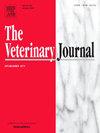Static respiratory compliance in anaesthetised and intubated brachycephalic dogs with and without brachycephalic obstructive airway syndrome
IF 3.1
2区 农林科学
Q1 VETERINARY SCIENCES
引用次数: 0
Abstract
The impact of brachycephalic obstructive airway syndrome in dogs (BOAS) on respiratory mechanics is unclear and may affect the choice of ventilation strategies during anaesthesia. This prospective study included 56 client-owned brachycephalic dogs, allocated to be BOAS (n = 26) or non-BOAS dogs (n = 30) based on functional grading. All dogs were anaesthetised using a standardised anaesthetic protocol. Pressure-controlled ventilation was initiated around 30 min post-induction, maintaining peak inspiratory pressure at 7–12 cm H2O. Static respiratory compliance (Cstat) was recorded at predetermined time points in sternal, right and left lateral recumbency. Thorax dimensions were assessed with a tape measure. Body surface area (BSA) was calculated and the ratio Cstat/BSA used as the main outcome variable. Comparison of means/medians, analysis of proportions, the Spearman correlation coefficient and both logistic and linear regression were used for data analysis. P < 0.05 was considered statistically significant. Non-BOAS dogs showed significantly higher Cstat/BSA compared to BOAS dogs in sternal (41.6 (31.1–51.8) vs. 32.9 (24.4 – 39.2), respectively, P = 0.028), right lateral (36.2 (25.7 – 46.4) vs. 27.0 (22.7 – 35.6); P = 0.026) and left lateral (33.6 (22.6 – 45.5) vs. 24.6 (18.4 – 32.2); P = 0.020) recumbencies. For all dogs, the Cstat/BSA ratio was higher in sternal compared to lateral recumbencies. BOAS dogs had a significantly shorter distance between thoracic inlet and last rib compared to non-BOAS dogs (20 ± 4 vs. 23 ± 6 cm, respectively; P = 0.043). Reduced respiratory compliance in BOAS-affected dogs should be considered during mechanical ventilation.
有无短头性阻塞性气道综合征的麻醉和插管短头犬的静态呼吸顺应性。
犬短头性阻塞性气道综合征(BOAS)对呼吸力学的影响尚不清楚,并可能影响麻醉期间通气策略的选择。这项前瞻性研究包括56只客户拥有的短头犬,根据功能分级分为BOAS犬(n = 26)和非BOAS犬(n = 30)。所有犬均采用标准化麻醉方案进行麻醉。诱导后30min左右开始压控通气,吸气压力峰值维持在7-12cm H2O。静呼吸顺应性(Cstat)记录在预定的时间点胸骨,右侧和左侧侧卧。用卷尺测量胸廓尺寸。计算体表面积(BSA),以Cstat/BSA比值作为主要结局变量。采用均值/中位数比较、比例分析、Spearman相关系数以及logistic和线性回归进行数据分析。P < 0.05为差异有统计学意义。非BOAS犬的胸骨Cstat/BSA分别为41.6(31.1-51.8)比32.9 (24.4 - 39.2),P = 0.028)和右侧(36.2(25.7 - 46.4)比27.0 (22.7 - 35.6);P = 0.026)和左外侧(33.6 (22.6 - 45.5)vs. 24.6 (18.4 - 32.2);P = 0.020)。对于所有犬,与侧卧位相比,胸骨侧卧位Cstat/BSA比值更高。与非BOAS犬相比,BOAS犬的胸入口处与最后一根肋骨之间的距离显著缩短(分别为20±4 cm对23±6cm);P = 0.043)。受boas影响的犬在机械通气时应考虑呼吸顺应性降低。
本文章由计算机程序翻译,如有差异,请以英文原文为准。
求助全文
约1分钟内获得全文
求助全文
来源期刊

Veterinary journal
农林科学-兽医学
CiteScore
4.10
自引率
4.50%
发文量
79
审稿时长
40 days
期刊介绍:
The Veterinary Journal (established 1875) publishes worldwide contributions on all aspects of veterinary science and its related subjects. It provides regular book reviews and a short communications section. The journal regularly commissions topical reviews and commentaries on features of major importance. Research areas include infectious diseases, applied biochemistry, parasitology, endocrinology, microbiology, immunology, pathology, pharmacology, physiology, molecular biology, immunogenetics, surgery, ophthalmology, dermatology and oncology.
 求助内容:
求助内容: 应助结果提醒方式:
应助结果提醒方式:


